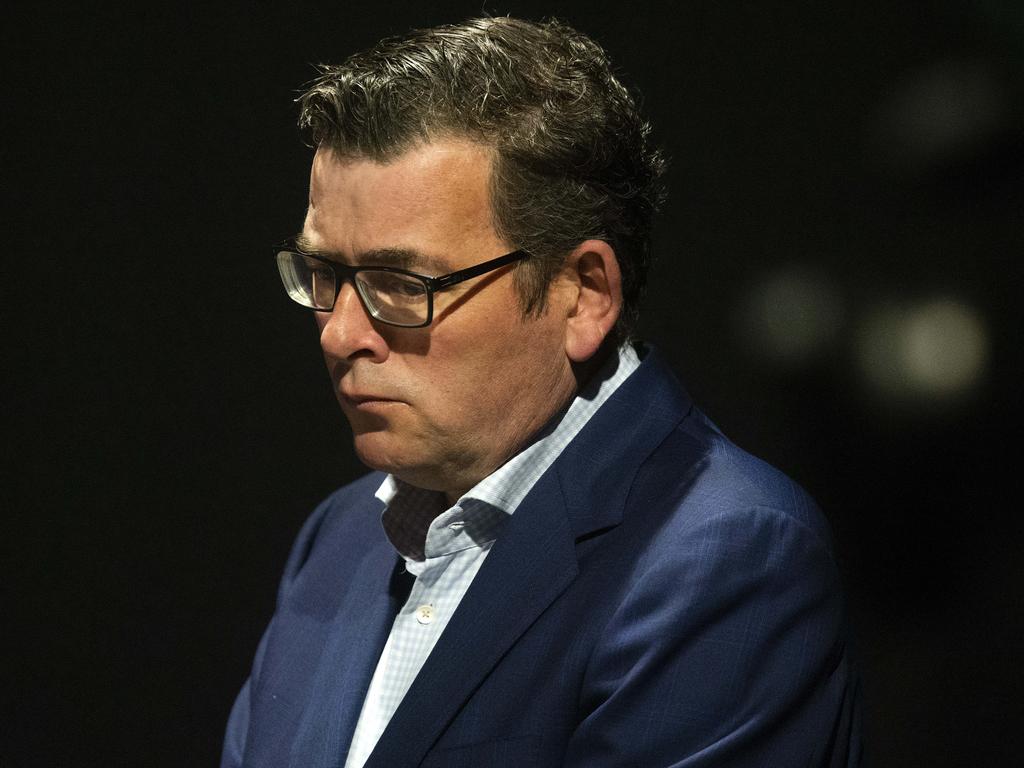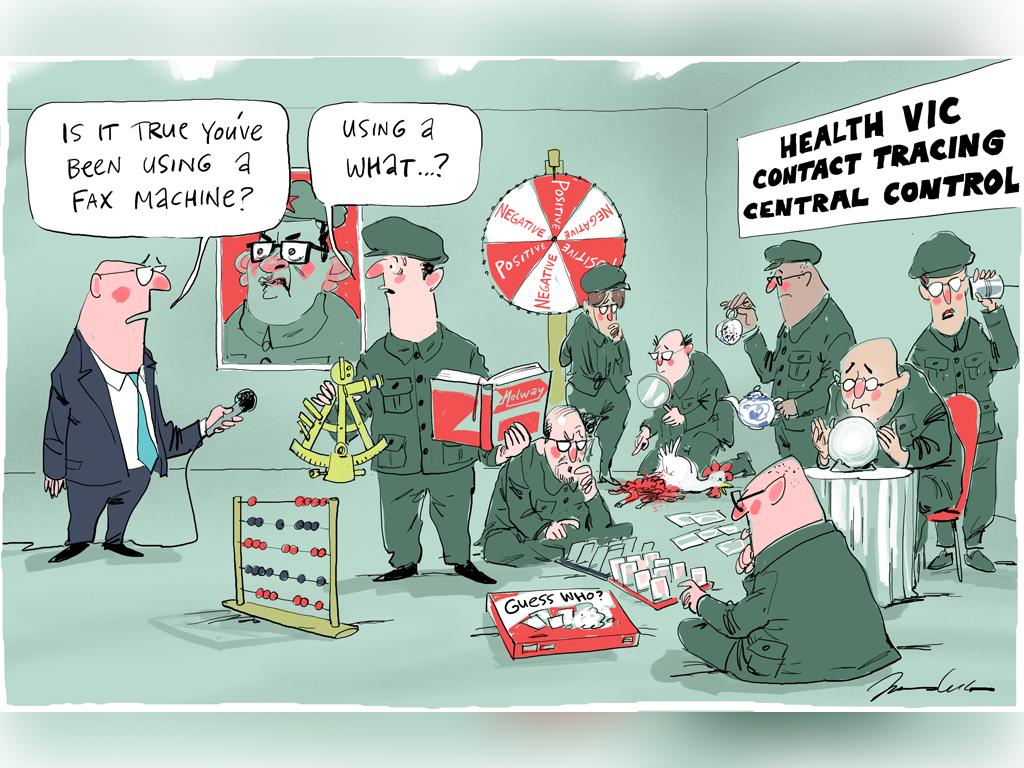Left out in the cold: low-key Daniel Andrews suddenly looks exposed

We are fortunate Australia’s response has been among the best in the world. Our number of cases has been relatively low, our hospital system has responded well and has not been overwhelmed (notwithstanding Victoria’s second wave), and our preparations to quickly manufacture a vaccine, when one becomes available, is ahead of most countries.
But significant challenges lie ahead. The economic impact has been dramatic and wide-ranging. Private sector business, particularly small business, has carried a disproportionate part of the burden, and many will not recover.
The pandemic has placed an intense spotlight on the governing style of political leaders across the world. The Morrison government’s response has been pragmatic and non-ideological. It reviewed the challenge and took the decisions it considered necessary — even if they are not those typically expected of a centre-right government. As a consequence, the full impact on the community has been eased by the quick introduction of JobKeeper and JobSeeker, along with many other stimulus measures.
The spotlight has also fallen on one of the most effective but deliberately low-key political operations ever seen in Australia.
Daniel Andrews is unarguably the leading centre-left political figure in Australia — and one of the most underestimated. His political style is emblematic of the best practice of left activist governments around the world. In fact, since the fall of the Wynne government in Ontario in 2018, Labor in Victoria is the most left-wing government in any significant democratic country. It is much more so than in any US state, or Nicola Sturgeon’s Scotland — or any of the Green coalition governments in Germany.
Andrews is not one of those political figures who will regret wasting his mandate. He has successfully implemented the most wide-ranging and radical social agenda seen in Australia. He has been able to so, in part, because his style is deliberately low-key and non-confrontational to avoid attracting attention to just how extensive his actions are. His longevity and success owes a lot to this style, which was tailored to the reduced reporting of state politics over the past decade.
The pandemic, however, has brought to prominence problems in government administration and decision-making in Victoria and has placed state Labor under much greater national scrutiny. As a consequence, the political management model that worked so effectively up until recently is arguably now contributing to the problems of the state, rather than helping resolve them.

Labor has governed in Victoria for almost 30 of the past 40 years. They have controlled senior appointments across the public sector for most of that time. This trend has increased rapidly since the election of the Andrews government in 2014, with comprehensive control of key parts of the bureaucracy being a key objective. Andrews, and his office, are widely rumoured to be active in shepherding key appointments. Public servants are expected to be “on the page”, and the Premier has been ruthless in removing those considered ineffective or unreliable.
But, as is typical when tribal or ideological loyalty is placed ahead of competence, overreach occurs and problems emerge. This is clearly now the case across a range of important portfolios in Victoria, where a growing number of problems are raising serious questions regarding the administration of the police, parts of the judiciary as well as health.
The political management model that served Andrews so well is now under strain as a result. Andrews himself has been health minister or premier for 10 of the past 13 years. No other individual has had greater influence on health policy and the development of the management structures for health in Victoria over that period. So if there is inadequate capacity for contact tracing, for example, he cannot claim ignorance.
But until recently his daily press conferences have been a master class in diverting attention from unwanted scrutiny. He has projected a style which, as Graham Richardson has said, exhibits “modesty with confidence”. His self-discipline means he rigorously sticks to his message and avoids anger or over-the-top rhetoric. This allows him to talk difficult issues down.
He normally rations his public appearances, avoids long one-on-one interviews and refuses to appear on some networks (Sky) or to be interviewed by commentators (such as Neil Mitchell at 3AW) who may push him. He narrows his field of public engagement and the issues he discusses, and he simply will not engage on some difficult topics.

As we see in his daily press conferences, he goes immediately to technical detail, often in great depth, to desensitise an issue and to give the impression he is “across the detail” and to provide endless diversionary issues on which to be questioned. It is common to have “experts” attend a press event to keep the focus on the detail and not on governance issues or unrelated difficult political issues.
He plays to his own constituencies and completely ignores those parts of the community he does not consider part of that group. He uses the power of his office to legitimatise his support base, including unions and activist NGOs, by consulting them and including them in decision-making while delegitimising others, such as small business, who are seen as either opponents or irrelevant to his political objectives.
In return, he demands total loyalty. Should a matter risk overwhelming his core message, an “inquiry” is often established “independently” to provide a shield to avoid further questions on the matter “while the Inquiry is underway”. And, in a direct take from the Kevin Rudd playbook, he often finds “I’ve not been briefed on that”. He regularly refuses to release information (e.g. genomic data) if it may prove embarrassing.
But the power of his message should not be underestimated. It is sophisticated and manipulative. It is not off-the-cuff or spontaneous but developed from research and extensive analysis of data from social media and other sources. Terms frequently heard at the daily press briefings such as “the advice of experts”, “we’ve all got to work together”, and “slow and steady recovery” come directly from this work.
Social media, much of it very targeted and beneath the wider public radar, has become the preferred channel of communication, allowing the Premier to ignore established television, radio and newspapers if he wishes. Significant public resources underpin this operation, which has one of the most extensive social media reaches in the state.
Andrews ignores parliament and limits the opportunities for the opposition to hold him, or his ministers, to account. He does not engage with the opposition or acknowledge any criticism from them. He dominates his party, caucus and ministry, expecting them to toe-the-line while otherwise ignoring them.
Long-term Labor supporters in Victoria must now be wondering if the model that has delivered great success for the party is now past its peak and, in fact, in danger of jeopardising the whole left project in Victoria.
The modern Labor era in Victoria began in the early 1970s when John Cain, Michael Duffy, John Button, Barry Jones and others came together to find a common basis to take the party forward. Many of those involved had been active in the conscription and capital punishment campaigns of the late 1960s. Central to their political outlook were notions the Andrews government must now find quaint: parliamentary scrutiny and accountability, transparency, disclosure through FOI, an independent legal system, an arm’s-length public service, broad consultation beyond Labor’s comfort zone of unions and interest groups — and, above all, governing for all Victorians.
The next state election in Victoria is on November 26, 2022. Labor has a strong majority which may be further strengthened by a coming redistribution. The Liberal and National parties will therefore face a huge challenge to win. But the disruption and scrutiny driven by the pandemic is changing politics and opening opportunities. The task for the Coalition, while difficult, is not impossible.
To win, the Coalition must be united, focused and ready. Over the next decade, Victoria will need innovative policies to revive the private sector and modernise the management of the public sector. The Liberals and Nationals have a competent and experienced team in the state parliament lead by Michael O’Brien.
Their first and most difficult challenge to winning has been to get Victorians to look at Labor with more sceptical eyes. Finally, as a consequence of hubris and overreach, and the heightened scrutiny driven by the pandemic, the Victorian community may be doing so.
Brian Loughnane is a business and political strategic adviser. He was the Coalition’s campaign director at four federal elections.







The global pandemic of 2020 is up-ending economies and disrupting politics across the world. The full consequences will play out over many years, possibly decades, but already major political parties are being redefined.